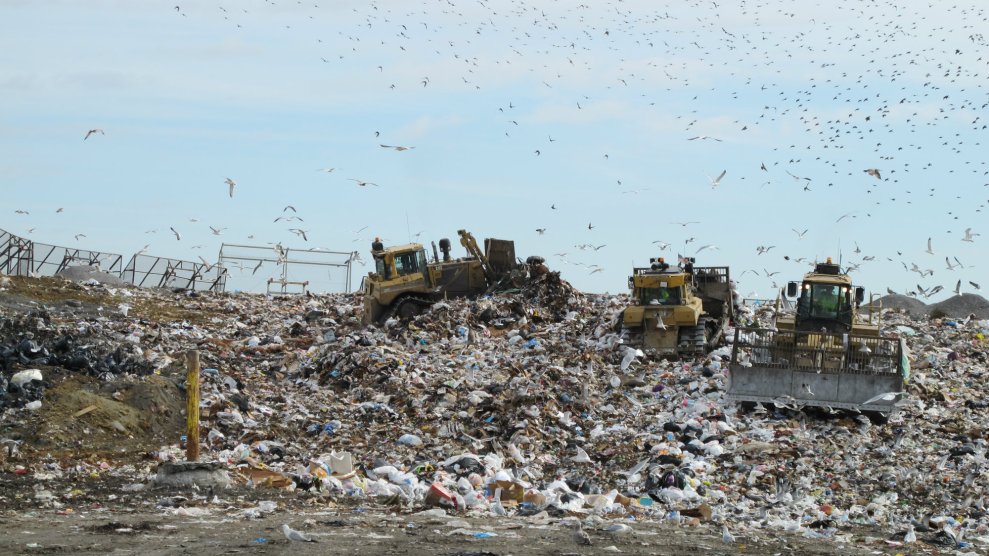
Bonnie Jo Mount/The Washington Post/Getty
This story was originally published by the Guardian and is shared here as part of the Climate Desk collaboration.
Sitting on a plastic chair in a small office, I’m wearing medical scrubs rolled up to my knees and I have an X-ray machine strapped to my shin.
The machine is scanning my bones for lead as an expert monitors readings streaming on to a screen.
Earlier that day, after arriving at a Mount Sinai facility in New York City, I dropped off a urine sample that will be studied for 81 chemicals in lab tests far more advanced than at a regular doctor visit.
A couple of weeks earlier, I spent five days wearing a silicone wristband designed to measure dangerous chemicals in my environment. I wore it while I cleaned my apartment, applied cosmetics, and commuted to work.
All this testing came during a six-month journey to try to answer what sounds like a very simple question: How toxic am I?
As an environment reporter for the Guardian in Washington, DC, I had noticed a growing number of experts expressing concerns about how Americans are exposed to potentially toxic chemicals just by living our everyday lives.
But how concerned should individuals be? How worried should I be?
Childhood in Cancer Alley
I grew up in south Louisiana, where cancer is a common part of life.
In Baton Rouge, I passed industrial facilities churning out gasoline and petrochemicals on drives to the airport or my favorite po boy shop for lunch. At home, I rarely thought about those chemicals when I moved my dad’s dirty coveralls from the washer to the dryer.
So when the Guardian decided to explore how Americans encounter toxic substances, I couldn’t turn my mind away from my own quiet worries. Tallying the people in my extended family who have died from cancer, I texted my parents. We stopped counting at eight.
The hour-long drive between my hometown and New Orleans is technically called the “petrochemical corridor,” but more Louisianans know it as Cancer Alley.
In Louisiana from 2011 to 2015, about 188 people out of 100,000 died each year from cancer, according to the CDC. That’s higher than all but three states: Kentucky, Mississippi, and West Virginia. One town outside New Orleans has a cancer rate 50 times higher than the national average because of toxic air.
Our “body burden”
Humans are more vulnerable to chemicals in utero and in youth, so my concerns aren’t unreasonable. Even the most health-conscious people have carcinogens and other harmful chemicals in their bodies—from plastics, cosmetics, cleansers, pesticide-soaked food, polluted air and water and the many other exposures that are a part of modern life.
All the chemicals together form what is known as a person’s “body burden”. Almost none of us can test ourselves to see our own body burdens. Doctors’ offices don’t offer the option and private labs don’t routinely test individuals and cost thousands of dollars.
With that in mind, I set out to quantify one person’s health risks from chemicals. As the complex world of toxicology unfolded, I realized just how much none of us know.
Of the tens of thousands of chemicals in commerce, scientists have closely studied the health impacts of roughly 50 to 100. The CDC records some of the average levels shown in the bodies of a representative sample of Americans.
We know what levels are average, but we don’t know what levels are safe. We also don’t know how various chemicals react together in the human body.
Individually, some of the chemicals commonly in use and in human bodies are known to be linked with cancer, organ problems, reproductive difficulties, endocrine disruption, obesity, diabetes, birth defects, neural issues and developmental delays. Together, we don’t know what they do.
One analysis of CDC data found that mixtures of chemicals can heighten toxicity in the body. But chemicals are typically studied only for their individual effects. And the existing research covers only a small fraction of chemicals people are exposed to—many more are unknown.
I didn’t understand most of this when I started working on this story.
The science of “exposomics”
I think of myself as a relatively cautious consumer. I buy most of my soaps and lotions at Whole Foods, but I don’t closely examine the hair products from my salon or the cleaning products I’ve always used. I eat mostly organic when I cook at home, but I dine out often too. Plastic is everywhere in my life, although I try to purchase as little of it as possible. I bought a special mattress specifically to avoid flame retardants.
So I was fascinated when I first heard of exposomics—the burgeoning study of how toxic chemicals affect a body over a lifetime.
“I like to say that exposomics is roughly where genomics was 15 years ago,” says Robert Wright, director of the Institute for Exposomic Research at Mount Sinai in New York.
“There’s a growing realization among geneticists that genetic information in the absence of environmental information doesn’t have very much value because everything interacts.”
In the US, Wright says, companies start using new chemicals and don’t stop using them unless people get sick and can prove how it happened. Medicines are tested before market, but most other products aren’t.
I know this, but hearing it from an expert makes me hyper aware of my environment. I start wearing socks after cleaning my floors. At a restaurant, I smell disinfectant and cringe at the silverware resting on the table.
Searching for tests
Wright tells me we can test my body for a small number of chemicals but we won’t know where in my life they’re coming from.
To examine my current-day risk, I can wear a newly developed silicone wristband designed by another researcher that will show what toxic substances I encounter in a given week.
For a longer history, we would need to analyze my baby teeth, which I don’t have. They would show signs of early exposures to toxic substances like lead and pesticides.
As I start seeking tests, I also find Leonardo Trasande, a doctor at New York University who helped a reporter with a similar experiment years ago. He tells me that unfortunately not much has changed since then.
Trasande suggests starting with four categories: phthalates, bisphenols, polybrominated diphenyl ethers (flame retardants) and organophosphate pesticides.
Aside from popping up in products and food, many of these chemicals enter the air, water and soil where they are manufactured and used.
I tick through my daily life and hypothesize that I probably have moderate levels of all four categories.
How much do we want to know?
Wright, the exposomics expert, says people educated about risks can reduce their toxic burdens, and this makes me feel my personal research is worthwhile.
However, Paolo Vineis, the chair of environmental epidemiology at Imperial College in London, tells me I should consider the psychological impact of my quest. He says he worries about a future where people are frequently testing their exposures. “I’m not sure it is good mental health to be that concerned about pollution,” he says.
Andreas Kortenkamp, a researcher looking at the effects of mixtures of chemicals, says there are limits to how much individuals can do. “It requires regulatory action from government,” he says.
What all the experts agree on, however, is that the best thing is to maintain a healthy lifestyle—to be active, eat fruits and vegetables and never smoke.
I’m unsure of how much I really want to know until I speak to Philippe Grandjean, a Harvard environmental pollution specialist who splits his time between Copenhagen and Cambridge, Massachusetts.
His studies have made him an expert in lead, mercury and most recently, synthetic nonstick perfluorinated chemicals, or PFAS , which most people have in their bodies.
“The lower you can get your exposure, the better, and simply use your brain,” Grandjean says. There may be bigger hazards we haven’t discovered “so we should try to limit our exposure to essentially all chemicals,” he adds.
Grandjean is also hyperaware. He doesn’t scrape melted cheese off chemically treated pizza boxes. He doesn’t eat popcorn microwaved in a bag.
If he can be that careful, I figure I can throw out some old perfumes and lotions. But for months while I’m learning about this invisible world, I try to keep my routines the same for the sake of our experiment.
The wristband test
After a few weeks, Kim Anderson, who developed the wristband for chemical testing at Oregon State University that Wright told me about, sends me a thick resealable plastic bag with a Livestrong-style bracelet.
For five days I don’t take it off. It’s bright orange and black, and I can’t help but notice it constantly. When I put on makeup or clean a counter, I think about whether it will show. When I take a deep breath, I wonder about the day’s air quality.
A photographer comes to document my everyday life and we line up my shower products on the edge of the bathtub. I feel overwhelmed: I don’t know much about the ingredients in what I use.
A few weeks later, Wright and Mount Sinai volunteer to test me for some of the chemicals the experts I’ve interviewed highlighted as important. I take a train to New York City and tour the lab where my samples will be collected and analyzed. Expensive machinery whirs all around.
I head to the bone scanner—which exposes me to a small fraction of the radiation involved in an annual dental X-ray. I was born in 1989, the year lead was phased out of gasoline. So if I was exposed, it was probably from old wall paint or drinking water pipes.
The full results of the lead test will take time to analyze, but Andrew Todd—who operated the machine on my leg—tells me I’m in the clear. “Because you’re not lighting up like a Christmas tree,” he says.
Lead is the only heavy metal we’re testing. The other tests we’ve arranged—after months of phone and video calls, emails and train trips—focus on the kinds of chemicals most Americans encounter every day, which worry me more.
Reviewing my products
With all my testing complete, I get home and start to make some changes.
I collect what I understand to be my riskiest products throughout my home, according to a database and app maintained by the Environmental Working Group, a health advocacy group.
I keep some of my personal care products and cosmetics but discard others. I struggle to part with a poorly rated hair cream I used since I was a teenager and perfumes that remind me of my first years in Washington, DC. I remind myself that cosmetics, and particularly fragrance, in the US are largely unregulated.
Friends who hear about the project ask if I’m scared. But I’m actually relieved to know I’m making better-educated decisions.
Then the results arrive.
The test results from my wristband
My wristband was analyzed for 1,530 chemicals. Twelve were detected, and the remaining 1,518 analytes were below the detection limit.
I Google the 12, and they sound terrifying, but I have no frame of reference. There is no database for chemicals Americans are exposed to on a daily basis.
Most on my list are fragrances used in body care products and cleaning supplies. Several are phthalates, the plasticizers used in food packaging and cosmetics. One is a flame retardant.
Olga Naidenko, a senior scientist at the Environmental Working Group, goes through the list with me. She notes phthalates can mimic hormones, affect the endocrine system and harm a developing fetus. She adds that the flame retardant—TPP—is used in some nail polishes and is another suspected endocrine disruptor.
Endocrine function is important to a healthy body. Endocrine disruptors can turn on or off, or modify, signals that hormones carry. They are linked with developmental, neural, immune and reproductive problems.
Naidenko reminds me that research can’t yet tell us the effects of cumulative exposure to multiple chemicals simultaneously.
“In EWG’s view, this question should have been answered by chemicals and products manufacturers before the chemicals were released on the market,” she says. “In the meantime, EWG recommends avoiding various possible sources of exposure to endocrine disrupting chemicals in everyday products.”
This, she adds, will “require a bit of detective work…since ingredients are not typically listed on consumer products.”
At first, I don’t aggressively pursue that detective work—I’m busy and I’ve been living this way without major problems for years, right? But I find I can’t help myself. Within the month I decide to start skipping pedicures and painting my toenails at home or not at all.
Results from the rest of my tests
When Mount Sinai completes my lab tests, Wright won’t send them to me until we talk. He knows I would go straight to Googling.
First he asks if I have chronic illnesses or take medications. I don’t, but I do take two pills a day for minor issues. I work in front of a computer, but I’m otherwise active and eat plenty of fruits and vegetables. I’m also gluten intolerant, so I skip many processed foods.
Wright tells me I have at least 36 chemicals in my body—phthalates, flame retardants and pesticides, as well as some phenols used in plastics and polycyclic aromatic hydrocarbons from air pollution.
I also have a metabolite from cigarette smoke, called cotinine. I don’t smoke and I’m rarely around smokers, but I did briefly visit relatives who were smoking two weeks before my test.
It’s remarkable to me that this could show up in my results.
“There’s no such thing as a ‘normal’ level for any of these chemicals,” Wright says.
But compared with the CDC data, I’m fairly average for a person living in a city.
Two of my phthalate levels are two to three times higher than the American average. Those are the chemicals found in my fancy soaps and shampoos. But they’re also in the plastic medicine capsules I swallow each day. And they’re in food packaging—like the plastic sheets that wrap American cheese. They are associated with obesity and reproductive problems, particularly for males.
“All those things are not directly causal, they’re risk factors,” Wright explains.
Even average levels aren’t necessarily healthy.
Trasande says he would have compared my numbers to the ranges of levels—rather than the averages—present in Americans. He says results like mine “are associated with a host of health consequences that can develop in folks who don’t have clinical symptoms of any disease or burden”. He counsels me to avoid the exposures I can.
But Wright says that since I don’t have any illnesses—like type 2 diabetes—he wouldn’t advise any extraordinary measures to limit my encounters with phthalates.
“My bet is you’re more in tune than most people and probably have a lower risk,” Wright says. He says taking your health seriously, “more than anything else, will help no matter what you’re exposed to and pretty much no matter what your DNA says.”
Based on one result, my elevated polycyclic aromatic hydrocarbons, I decide to get a big fan and open the window when I cook over my stove.
My kitchen doesn’t have an exhaust. It’s unclear whether the air pollution my labs show is from cars in a traffic jam or smoke inside my home.
“I think the important message is it’s not that we think that all chemicals should be banned,” Wright says. “Chemicals have positive uses. It’s just that we need to be aware of what’s in [products] and then make informed choices.”
















